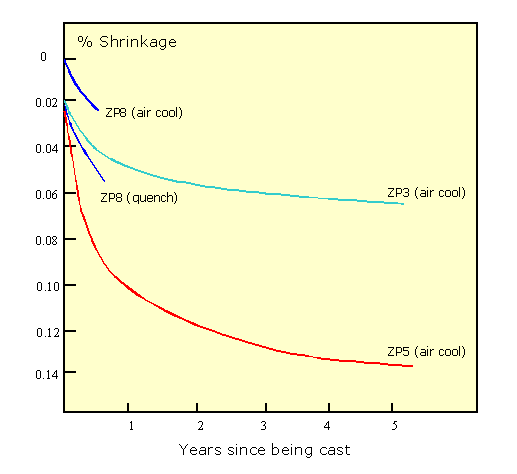Zinc Diecasting Alloys
Physical Properties
Table of Properties
| Short Designation | ZP3 | ZP5 | ZP2 | ZP8 |
| Specific Gravity at 21°C (zero porosity) |
6.6 | 6.76 | 6.8 | 6.3 |
| Thermal Expansion at 20-100°C, µm/m/°C |
27 | 27.2 | 27.2 | 27.3 |
| Thermal Conductivity at 70-140°C, Wm-1 °C-1 |
113.0 | 108.9 | 104.7 | 114.7 |
| Specific Heat Capacity J/kg/°C at 20-100°C |
418.7 | 418.7 | 418.7 | 435.4 |
| Electrical Conductivity % IACS | 27 | 27.2 | 27.2 | 27.4 |
| Melting Temperature Range °C | 381-387 | 380-386 | 379-390 | 375-404 |
Heat Sink Design
The most generally useful physical properties of these alloys are their good conductivity of heat and electricity, making them useful for such items as heat sinks, wave-guides and EMI shielding. For use in this former application see “A computer program for the design of simple heat sinks” by R. Bragg, N. Zhang and P.J.Heggs (UMIST) and F.Goodwin (ILZRO)
At low frequencies the damping capacity of zinc alloys are good enough for them to be on the verge of being considered as “Hidamets”- (high damping metals.) For further information on this subject see High damping zinc aluminium alloys.
Dimensional Stability
Like other materials zinc diecastings are subject to very small dimensional changes after casting. For most purposes they are so small as to be negligible. However because zinc diecastings are frequently used for high precision components this dimensional change may need to be taken into account.
Long-Term Shrinkage Data For Alloys ZP3, ZP5 And ZP8
The amount of post casting shrinkage is influenced by the rate of cooling both in the die and immediately after ejection. The faster the cooling the more post casting shrinkage that can be expected. In consequence the greatest shrinkage can be expected of a thin section casting quenched in cold water immediately following ejection. Note however that such a casting measured immediately after casting would be slightly larger than the same part naturally cooled. This effect is graphically illustrated below.
Effect Of Casting Cooling Conditions On Shrinkage Due To Ageing,
(test casting in ZP5)
It is clear that the casting is tending towards the same stable dimension in each case, but quenching delays the shrinkage. Where contractions such as these cannot be tolerated they can largely be brought forward by a simple stabilisation heat treatment such as:
3 to 6 hours at 100°C
or 5 to 10 hours at 85°C
or 10 to 20 hours at 70°C
Subsequent to this treatment the following table indicates the dimensional stability.
Dimensional Stability As Stabilised
|
Contraction %
|
|||
|
ZP3
|
ZP5
|
ZP2
|
|
| 5 weeks |
0.02
|
0.021
|
0.022
|
| 3 months |
0.03
|
0.026
|
0.026
|
| 2 Years |
0.03
|
0.037
|
0.037
|
References 7, reference 9 and reference 10
Spark Resistance
All of the zinc diecasting alloys featured in this publication can be considered to be non-sparking. They conform to the limits specified in EN 13463-1:2001 Non-electrical equipment for potentially explosive atmospheres. Basic method and requirements ie they contain less than 15% aluminium, magnesium, titanium and zirconium together, and not more than 6% magnesium, titanium or zirconium individually.

